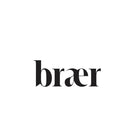Studio Visit - Jacqui Sos
by BRÆR Studio
·
We wandered up a quiet laneway in Mullumbimby, on Bundjalung country to visit Jacqui Sos so she could show us the final stage of her process of making her pots. The back laneways in Mullumbimby are hideaways for a lot of local artists working in many mediums.
Jacqui uses a few different techniques to create her signature earth toned glazes and textures on her pots and Ikebana inspired vases. Jacqui has studied Ikebana (Japanese style flower arranging) and is influenced by the design sensibilities of Japan. She uses her knowledge to create vessels with flowers in mind.

Jacqui is a teacher turned potter and she enjoys teaching and demonstrating how she creates her wonderful glazes using ancient techniques called Raku and Obvara (pronounced ob-vara and is sometimes known as "Baltic raku").
Like all potters, she is a mad scientist of sorts. We approach her studio just in time to see her and her husband, Sam assisting her to fire up a big homemade kiln made from a 44 gallon drum tipped on its side. Jacqui and Sam have been working on this kiln design for some time and hope to be able to create them for other potters soon too.

Jacqui suits up in her thick leather gloves and face shield to open the kiln and place some of her pots inside. The kiln holds about 4 or so large pots on what looks like a concrete barbecue plate. We then get to take a look around Jacqui and Sam's beautiful back-garden studio filled to the brim with ceramics and Sam's sketches and prints.



Once the kiln is at its optimum temperature Jacqui suits up again and shows us the prepared liquid glaze she will dip the Obvara pots in after taking them out of the kiln. The liquid is made from simple ingredients of flour, sugar, yeast and water which will react and bake on to the outside of the pots in an alchemistic way. No two pots are the same as the glaze medium reacts in unique ways every time.


Obvara originated in Eastern Europe (mainly Ukraine, Belarus, Estonia, and Latvia) around the 12th century. Obvara is not purely decorative either; it’s said to have spiritual connotations where potters and locals from the villages would believe that the Obvara pattern of eyes that occurred "protected the food their pots held from evil spirits." Obvara pots also absorb moisture very well, so they are known to be great for cooking in.
Jacqui explains this history and we stand back and watch the two artists work together to remove the pots from the kiln one-by-one with a pair of tongs before transferring it to the yeast mixture and then into the water bath. The pots bubble and hiss when in the water bath as they rapidly cool. The process is fast paced and exciting!

The next round of pots are destined for the Raku technique. Azzmin is instructed to throw saw dust on the pots that Jacqui will retrieve from the kiln with tongs while still red hot and be placed on a concrete tile. The sawdust will light on fire on the pots and a metal bucket will be placed upside-down on top of them to create a smoking and cooling chamber.


The glaze and slip Jacqui has applied to the bisque ware cracks during the rapid temperature changes within the over-turned-bucket cooling chamber. This leaves the underlying clay body exposed in the cracked areas. The carbon circulating in the reduction atmosphere blackens the exposed areas. This results in the distinctive black crack marks that are associated with Raku pottery.

Every morning around 6:00am you’ll find Jacqui in her Studio playing in the mud.
Jacqui Says "You need to centre the clay, but the clay also centres you and I’ve never been so happy."
Shop the full range of Jacqui Sos ceramics on our website here
Visit us in store to see the textures and shapes of the vases in person or visit Jacqui's studio on the 2022 North Coast Mud Trail
Words by Azzmin. Photos in this Profile by Yaz Ward.
